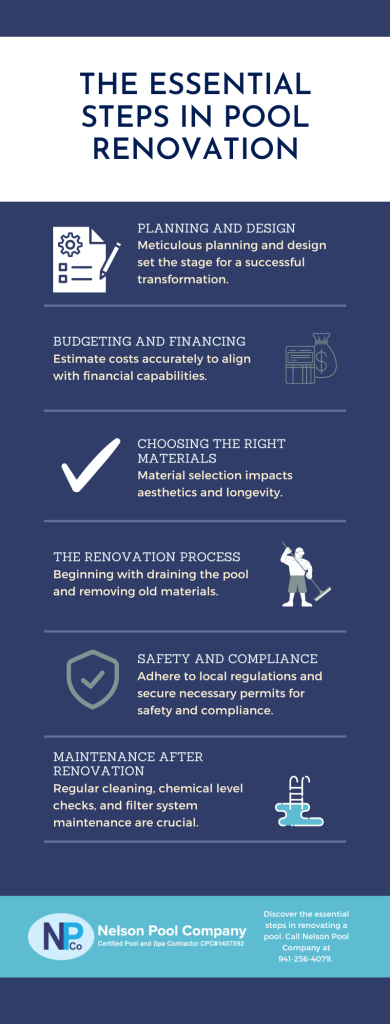How about transforming your swimming pool into a stunning backyard centerpiece? At Nelson Pool Company, we recognize that pool renovation is more than just a project—it’s about bringing your dream pool to life.
Renovating a pool requires meticulous planning, a keen eye for design, and precise execution. That’s where our expertise comes in. This comprehensive guide is crafted to navigate you through the essential steps of the pool renovation journey.
Whether you’re aiming for a minor refresh or a complete transformation, we aim to ensure your renovation experience is as seamless and satisfying as possible. From the initial design concepts to the final reveal, we’re here to support and guide you every step of the way.
Let’s dive into pool renovation, where your vision meets our craftsmanship to create something spectacular.

What Are The Processes Involved In Renovating A Pool?
Several critical processes come into play when embarking on a pool renovation project.
Planning and Design
The initial phase of any pool renovation project hinges on meticulous planning and design. These two elements set the stage for a successful transformation. The importance of planning must be balanced; the blueprint guides the entire renovation process.
This stage involves making critical decisions about the pool’s size, shape, depth, and style, ensuring these elements align with your aesthetic desires and functional needs.
When actualizing these plans, homeowners often find themselves at a crossroads: hiring a professional or opting for a DIY approach. While DIY might seem appealing, especially from a cost perspective, a professional’s expertise and experience are invaluable.
Professionals not only help navigate complex design choices but also foresee potential challenges and offer solutions that may need to be made apparent to the untrained eye.
Design considerations are the heart of planning. The size and shape of the pool complement the landscape and space available. Depth varies based on usage, whether for family entertainment or diving.
The style, from modern, sleek lines to more naturalistic designs, should reflect your personal taste and enhance your home’s overall aesthetic. Thoughtful planning and design, ideally with professional guidance, lay the groundwork for a pool renovation that meets your expectations and brings lasting enjoyment.

Budgeting and Financing
A crucial aspect of pool renovation is the budgeting and financing process, ensuring the project aligns with your financial capabilities. Estimating the costs accurately is the first step in this journey.
It encompasses various elements like labor, materials, design complexities, and any additional features you plan to include. Remember, unexpected expenses can arise, so it’s wise to include a contingency fund in your budget.
Exploring financing options is equally essential. Many homeowners opt for home equity loans or lines of credit, which can offer favorable interest rates. Alternatively, depending on your credit history and financial situation, personal loans or pool renovation-specific financing plans might be suitable.
It’s advisable to shop around and compare different financing options to find the one that best suits your needs.
To save money, consider phasing out your project. Tackle the most urgent renovations first and gradually move to aesthetic enhancements. Choosing cost-effective materials and features that offer durability without the hefty price tag can also help keep costs down.
Furthermore, some tasks, like preliminary cleaning or minor demolitions, can be DIY-ed, reducing labor costs. Strategic planning, exploring various financing avenues, and wise choices can help you manage your budget effectively while achieving the pool renovation of your dreams.

Choosing the Right Materials
Selecting suitable materials is a pivotal step in pool renovation, impacting your pool’s aesthetics and longevity. Common materials include tiles, plaster, and fiberglass, each offering unique benefits.
Tiles are renowned for their durability and variety in design, allowing for personalized patterns and colors. Plaster, a more traditional option, offers a smooth finish and comes in different colors to enhance the pool’s visual appeal. Fiberglass is favored for its low maintenance and resistance to algae.
Durability and maintenance are significant factors to consider. While tiles can withstand harsh chemicals and temperature fluctuations, they may require re-grouting over time. Though less durable than tiles, plaster is cost-effective and can be easily resurfaced. Fiberglass stands out for its minimal maintenance needs, resisting stains and requiring less frequent repairs.
Aesthetics play a crucial role in material selection. The choice should complement your home’s overall style and landscape design. Whether you’re looking for a classic, elegant look with plaster or a modern, customized design with tiles, the material should align with your vision for the space.
Each material comes with its own set of advantages and considerations. Balancing durability, maintenance, and aesthetic preferences will guide you in choosing suitable materials for your pool renovation, ensuring a beautiful and long-lasting outcome.

The Renovation Process
The pool renovation process is a detailed and systematic journey that transforms your old pool into a rejuvenated backyard haven. It begins with draining the pool, a critical step that prepares the pool for the forthcoming alterations. Following this, the old materials are carefully removed.
This step is crucial, especially in cases where the pool’s structure is significantly altered or upgraded.
Next, the pool undergoes necessary repairs and surface preparations. This stage is vital for ensuring the longevity and safety of the pool, addressing issues like cracks or leaks, and preparing surfaces for new materials. The choice of materials, as discussed earlier, plays a key role here, determining the pool’s durability and overall aesthetic.
Installing new materials is meticulous, requiring precision and attention to detail. This stage brings the design vision to life, whether it’s through laying new tiles, applying fresh plaster, or fitting in a fiberglass shell. The renovation also often includes updating or installing new plumbing and electrical systems, ensuring that the pool looks good and functions optimally.
Adding features like lighting, waterfalls, or spas is often part of the renovation process. These features can enhance the functionality and aesthetic appeal of the pool, creating a more enjoyable and relaxing environment.
Finally, the pool is refilled, and the finishing touches are added. This includes final checks and adjustments to ensure everything functions as it should. The renovation process, while complex, results in a transformed pool that aligns with your desires and needs, providing a refreshing and enjoyable outdoor space for years to come.
Safety and Compliance
Adhering to local regulations and securing the necessary permits is essential to any pool renovation project. This compliance ensures that your pool meets all safety and construction standards set by local authorities.
Before beginning the renovation, it’s crucial to understand and follow these regulations, which vary based on location. These rules often pertain to the pool’s depth, fencing, and the use of certain materials, ensuring the safety of the construction team during renovation and pool users post-renovation.
Additionally, it’s essential to work with contractors who are knowledgeable about these regulations and committed to following them. This ensures a legally compliant renovation and provides peace of mind that your pool area is safe for family and friends. After the renovation, regular inspections and maintenance are vital to sustaining compliance and ensuring ongoing safety.
Please include attribution to https://sarasotapoolleakdetection.com with this graphic.
Maintenance After Renovation
Post-renovation, maintaining your newly upgraded pool is crucial for preserving its condition and ensuring long-term enjoyment. Regular maintenance is critical. This includes routine cleaning to keep the water crystal clear and debris-free.
Check and balance the chemical levels weekly to prevent algae growth and maintain pH levels, ensuring a safe swimming environment.
It’s also important to regularly inspect and clean the pool’s filter system, as a well-functioning filter is essential for keeping the water clean. Seasonal checks of the pool’s structure, especially after harsh weather, can help identify and address minor issues before they escalate.
Specific care should be taken for those with renovated surfaces like tiles or plaster to avoid damage. Use gentle, non-abrasive cleaners to preserve the finish and integrity of these materials.
Remember, consistent care and attention will not only extend the life of your pool but also enhance your swimming experience. Consulting with pool maintenance professionals can provide more personalized advice tailored to your specific pool type and renovation features.
Embarking on a pool renovation journey is an exciting venture that revitalizes your outdoor space and enhances your home’s value. Each step, from the initial planning to the long-term care, transforms your pool into a stunning and enjoyable retreat.
If you’re considering renovating your pool and need expert guidance, Nelson Pool Company is here to help. With our expertise and commitment to quality, we’ll ensure your pool renovation journey is smooth and rewarding. Contact us today to start bringing your dream pool to life!
